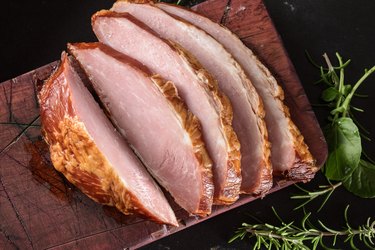
Even though many hams sold in stores are fully cooked, it's tradition — and very tasty — to glaze and cook the ham before serving it. Cooking ham in a convection oven means adjusting both temperature and cook time slightly from conventional oven recipes.
Choosing Your Ham
Video of the Day
Ham comes in so many types that the USDA Food Safety and Inspection Service (USDA FSIS) published an entire article to clarify the differences between them and how each type should be prepared. So before you start cooking, make sure you know what kind of ham you're dealing with.
Video of the Day
One of the biggest questions you may face: What's the difference between cured and uncured ham? Curing is the process of adding salt, nitrites or nitrates, and other seasonings to help preserve the meat and develop its color and flavor. The curing spices may be rubbed onto the meat or injected into it, and they typically impart a rich flavor and a color that may range from deep pink to mahogany, depending on the process used.
Your ham may also be smoked, boiled or, less commonly, completely uncured. The latter is known as a "fresh" ham and will be labeled as such; it'll also be pale beige or pink, like an uncooked pork roast.
Because there is so much variation among different types of ham, even the USDA FSIS recommends carefully reading the label on your ham to be sure of which type you have and how to properly prepare it.
Prep Your Ham and Glaze
In most cases, you'll be dealing with a fully cooked ham. Prepare it by trimming away excess fat and scoring it all over with a sharp knife. Make these shallow cuts in opposing directions to create a square or diamond pattern for better coverage.
Place the ham on a rack in a broiling pan; place a whole ham on its side or, if you're dealing with a cut ham, place it cut-side down. If you add some water to the bottom of the pan this will help keep the ham moist, and adding herbs to the water will also flavor the ham. If you don't have a cover for the broiling pan, create a foil tent over the ham.
Next, combine sweet and tangy ingredients to create a glaze. You can get a simple, delicious glaze by combining brown sugar, Dijon mustard and apple cider vinegar to taste, then simmering until the glaze is reduced by about half. Other common glaze ingredients include honey, rice vinegar, pepper, Worcestershire sauce and assorted spices.
Preheat the Oven
As you're prepping the ham, set the oven to preheat. Most of the cooking temperatures published for ham are calculated for a conventional oven. If you're using a convection oven instead, most experts recommend setting your convection oven to 25 degrees Fahrenheit lower than you'd use for a conventional oven.
If your ham doesn't have specific temperature directions on it, the USDA FSIS recommends setting a conventional oven no lower than 325 F to reheat a pre-cooked ham — which translates to 300 F for a convection oven.
Once the oven is preheated, slide the pan into its center. Expert recommendations vary on how often you should glaze your ham; some say to coat it every 10 to 20 minutes and baste it with juices from the pan while you're at it, while others say a single glaze, about 20 minutes before the ham is done, is enough.
For a sensational, caramelized crust on your glazed ham, glaze it frequently and then, at the tail end of the cooking time, remove the foil tent or lid from your ham and set the oven to broil for a couple of minutes. Watch carefully to make sure the ham doesn't burn.
Check for Doneness
As the University of Kentucky explains, convection ovens cook food faster than a conventional oven does — your food may be done up to 25 percent more quickly. But converting convection oven vs. regular cooking times isn't an exact science. You can guarantee good results and food safety by using a meat thermometer to gauge when your ham is done.
According to FoodSafety.gov, a cooked ham (which is what you'll most commonly find in stores) should be reheated to an internal temperature of 165 F — although they allow an exception of 140 F for cooked hams that were packaged in a USDA-inspected plant. If you're working with a fresh ham, it should be heated to an internal temperature of 145 F, then allowed to rest for three minutes.
In either case, if you have an oven-safe leave-in thermometer, you can monitor the ham's internal temperature without even opening the oven door.
The USDA FSIS recommends placing your meat thermometer midway into the cut of meat; if the bone is still in your ham, place the thermometer to avoid it. And if your ham is an irregular shape, check its temperature in several places to be sure it's cooked all the way through.